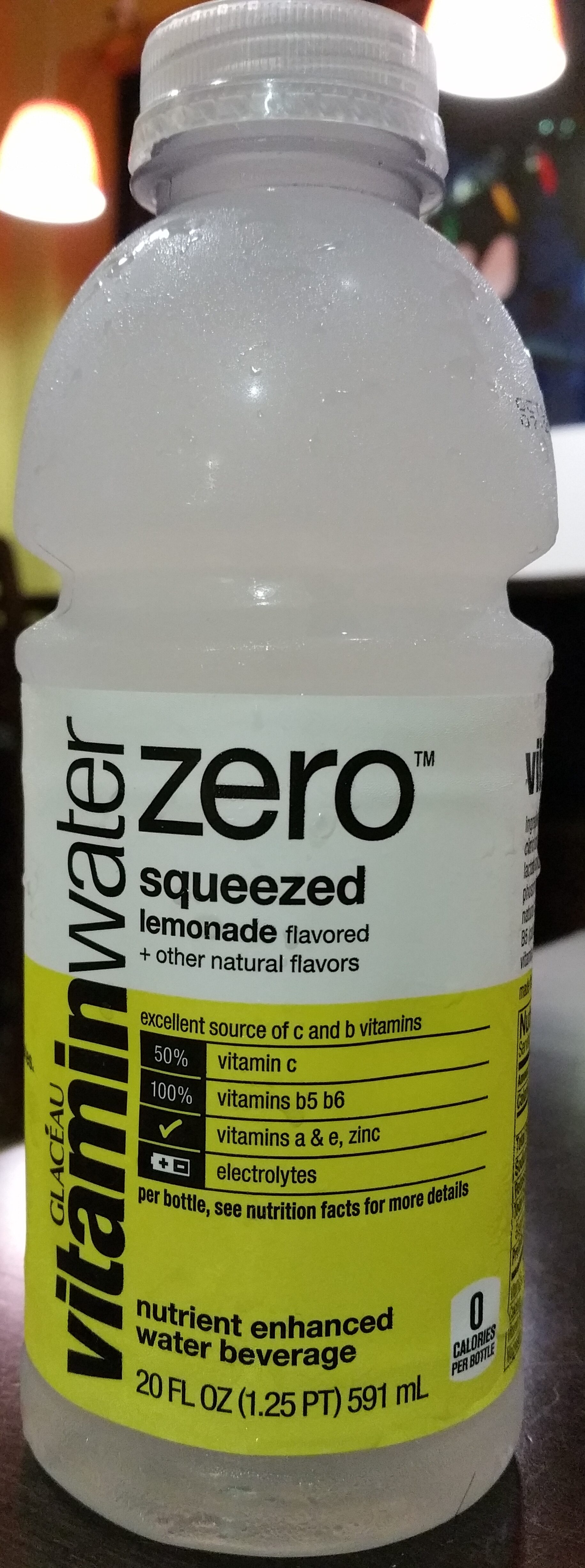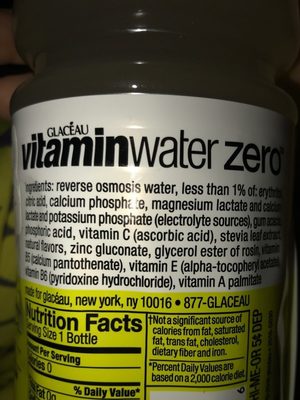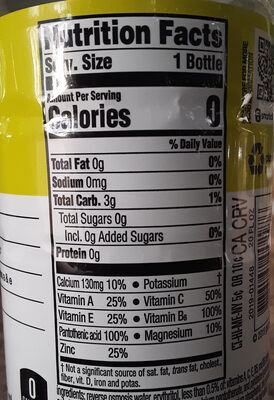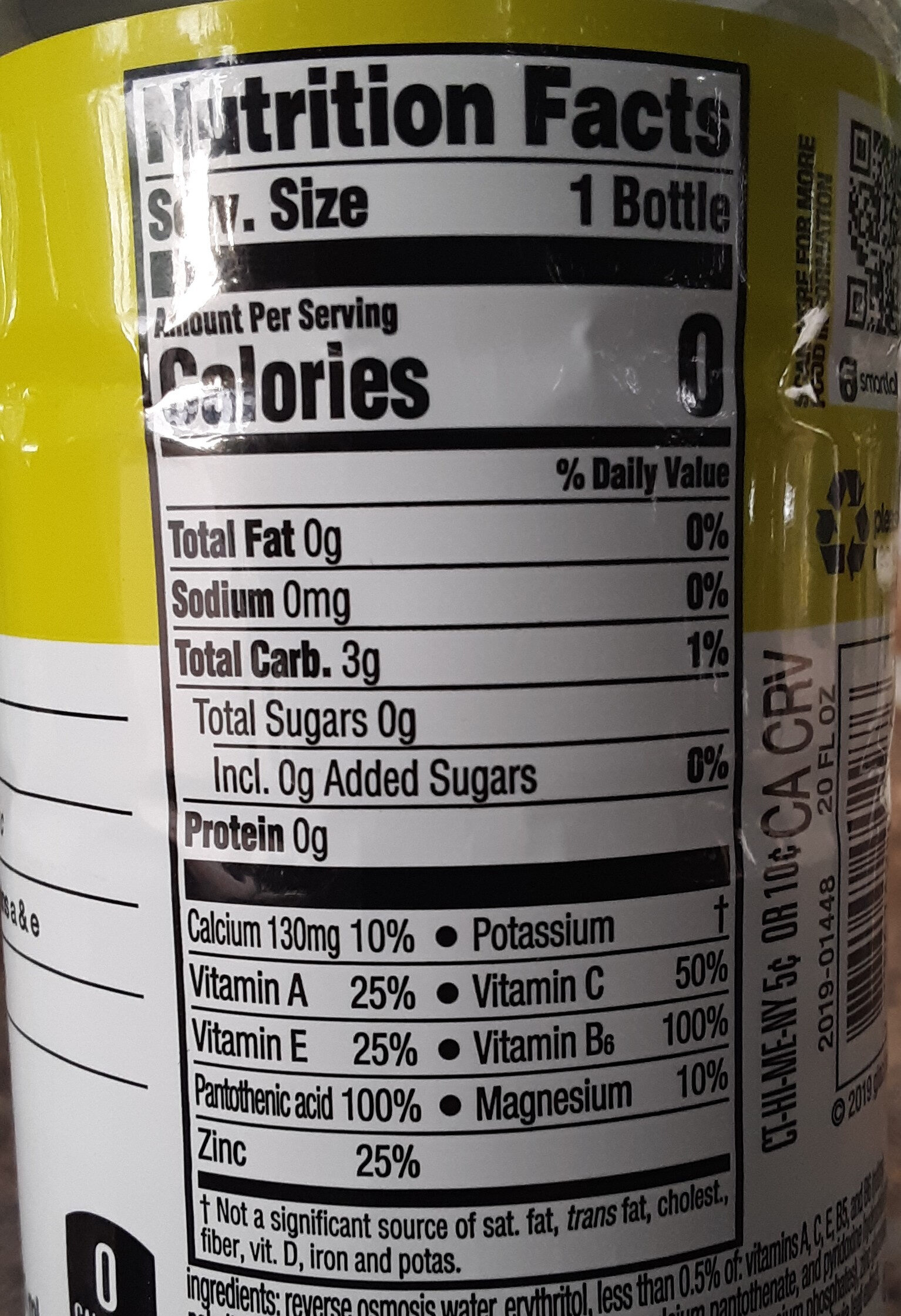Help us make food transparency the norm!
As a non-profit organization, we depend on your donations to continue informing consumers around the world about what they eat.
The food revolution starts with you!
Vitamin water, vitaminwater zero squeezed, lemonade, lemonade - Glaceau
Vitamin water, vitaminwater zero squeezed, lemonade, lemonade - Glaceau
This product page is not complete. You can help to complete it by editing it and adding more data from the photos we have, or by taking more photos using the app for Android or iPhone/iPad. Thank you!
×
Barcode: 0786162002976 (EAN / EAN-13) 786162002976 (UPC / UPC-A)
Packaging: Pet-bottle
Brands: Glaceau
Brand owner: Energy Brands Inc.-Glaceau
Categories: Beverages, Carbonated drinks, Waters, Sodas, Lemonade, Sweetened beverages
Countries where sold: France, United States
Matching with your preferences
Health
Ingredients
-
23 ingredients
Reverse osmosis water, less than 1% of: erythritol, citric acid, calcium phosphate, magnesium lactate and calcium lactate and potassium phosphate (electrolyte source), gum acacia, phosphoric acid, vitamin c (ascorbic acid), stevia leaf extract, natural flavors, zinc gluconate, glycerol ester of rosin, vitamin b5 (calcium pantothenate), vitamin e (alpha-tocopheryl acetate), vitamin b6 (pyridoxine hydrochloride), vitamin a palmitate.
Food processing
-
Ultra processed foods
Elements that indicate the product is in the 4 - Ultra processed food and drink products group:
- Additive: E414 - Acacia gum
- Additive: E960 - Steviol glycosides
- Additive: E968 - Erythritol
- Ingredient: Flavouring
Food products are classified into 4 groups according to their degree of processing:
- Unprocessed or minimally processed foods
- Processed culinary ingredients
- Processed foods
- Ultra processed foods
The determination of the group is based on the category of the product and on the ingredients it contains.
Additives
-
E330 - Citric acid
Citric acid is a natural organic acid found in citrus fruits such as lemons, oranges, and limes.
It is widely used in the food industry as a flavor enhancer, acidulant, and preservative due to its tart and refreshing taste.
Citric acid is safe for consumption when used in moderation and is considered a generally recognized as safe (GRAS) food additive by regulatory agencies worldwide.
-
E338 - Phosphoric acid
Phosphoric acid: Phosphoric acid -also known as orthophosphoric acid or phosphoricV acid- is a weak acid with the chemical formula H3PO4. Orthophosphoric acid refers to phosphoric acid, which is the IUPAC name for this compound. The prefix ortho- is used to distinguish the acid from related phosphoric acids, called polyphosphoric acids. Orthophosphoric acid is a non-toxic acid, which, when pure, is a solid at room temperature and pressure. The conjugate base of phosphoric acid is the dihydrogen phosphate ion, H2PO−4, which in turn has a conjugate base of hydrogen phosphate, HPO2−4, which has a conjugate base of phosphate, PO3−4. Phosphates are essential for life.The most common source of phosphoric acid is an 85% aqueous solution; such solutions are colourless, odourless, and non-volatile. The 85% solution is a syrupy liquid, but still pourable. Although phosphoric acid does not meet the strict definition of a strong acid, the 85% solution is acidic enough to be corrosive. Because of the high percentage of phosphoric acid in this reagent, at least some of the orthophosphoric acid is condensed into polyphosphoric acids; for the sake of labeling and simplicity, the 85% represents H3PO4 as if it were all in the ortho form. Dilute aqueous solutions of phosphoric acid exist in the ortho form.Source: Wikipedia
-
E414 - Acacia gum
Gum arabic: Gum arabic, also known as acacia gum, arabic gum, gum acacia, acacia, Senegal gum and Indian gum, and by other names, is a natural gum consisting of the hardened sap of various species of the acacia tree. Originally, gum arabic was collected from Acacia nilotica which was called the "gum arabic tree"; in the present day, gum arabic is collected from acacia species, predominantly Acacia senegal and Vachellia -Acacia- seyal; the term "gum arabic" does not indicate a particular botanical source. In a few cases so‐called "gum arabic" may not even have been collected from Acacia species, but may originate from Combretum, Albizia or some other genus. Producers harvest the gum commercially from wild trees, mostly in Sudan -80%- and throughout the Sahel, from Senegal to Somalia—though it is historically cultivated in Arabia and West Asia. Gum arabic is a complex mixture of glycoproteins and polysaccharides. It is the original source of the sugars arabinose and ribose, both of which were first discovered and isolated from it, and are named after it. Gum arabic is soluble in water. It is edible, and used primarily in the food industry as a stabilizer, with EU E number E414. Gum arabic is a key ingredient in traditional lithography and is used in printing, paint production, glue, cosmetics and various industrial applications, including viscosity control in inks and in textile industries, though less expensive materials compete with it for many of these roles. While gum arabic is now produced throughout the African Sahel, it is still harvested and used in the Middle East.Source: Wikipedia
-
E960 - Steviol glycosides
Steviol glycoside: Steviol glycosides are the chemical compounds responsible for the sweet taste of the leaves of the South American plant Stevia rebaudiana -Asteraceae- and the main ingredients -or precursors- of many sweeteners marketed under the generic name stevia and several trade names. They also occur in the related species Stevia phlebophylla -but in no other species of Stevia- and in the plant Rubus chingii -Rosaceae-.Steviol glycosides from Stevia rebaudiana have been reported to be between 30 and 320 times sweeter than sucrose, although there is some disagreement in the technical literature about these numbers. They are heat-stable, pH-stable, and do not ferment. Additionally, they do not induce a glycemic response when ingested, because humans can not metabolize stevia. This makes them attractive as natural sugar substitutes for diabetics and other people on carbohydrate-controlled diets. Steviol glycosides stimulate the insulin secretion through potentiation of the β-cell, preventing high blood glucose after a meal. The acceptable daily intake -ADI- for steviol glycosides, expressed as steviol equivalents, has been established to be 4 mg/kg body weight/day, and is based on no observed effects of a 100 fold higher dose in a rat study.Source: Wikipedia
-
E968 - Erythritol
Erythritol: Erythritol --2R,3S--butane-1‚2,3‚4-tetrol- is a sugar alcohol -or polyol- that has been approved for use as a food additive in the United States and throughout much of the world. It was discovered in 1848 by Scottish chemist John Stenhouse. It occurs naturally in some fruit and fermented foods. At the industrial level, it is produced from glucose by fermentation with a yeast, Moniliella pollinis. Erythritol is 60–70% as sweet as sucrose -table sugar- yet it is almost noncaloric, does not affect blood sugar, does not cause tooth decay, and is partially absorbed by the body, excreted in urine and feces. Under U.S. Food and Drug Administration -FDA- labeling requirements, it has a caloric value of 0.2 kilocalories per gram -95% less than sugar and other carbohydrates-, though nutritional labeling varies from country to country. Some countries, such as Japan and the United States, label it as zero-calorie; the European Union labels it 0 kcal/g.Source: Wikipedia
Ingredients analysis
-
Palm oil free
No ingredients containing palm oil detected
Unrecognized ingredients: Reverse-osmosis-water, Less-than-1-of, Magnesium-lactate-and-calcium-lactate-and-potassium-phosphate, Electrolyte-source, Glycerol-ester-of-rosinSome ingredients could not be recognized.
We need your help!
You can help us recognize more ingredients and better analyze the list of ingredients for this product and others:
- Edit this product page to correct spelling mistakes in the ingredients list, and/or to remove ingredients in other languages and sentences that are not related to the ingredients.
- Add new entries, synonyms or translations to our multilingual lists of ingredients, ingredient processing methods, and labels.
If you would like to help, join the #ingredients channel on our Slack discussion space and/or learn about ingredients analysis on our wiki. Thank you!
-
Vegan status unknown
Unrecognized ingredients: Reverse-osmosis-water, Less-than-1-of, Magnesium-lactate-and-calcium-lactate-and-potassium-phosphate, Electrolyte-source, Vitamin C, Zinc gluconate, Glycerol-ester-of-rosin, Vitamin E, D-alpha tocopheryl acetateSome ingredients could not be recognized.
We need your help!
You can help us recognize more ingredients and better analyze the list of ingredients for this product and others:
- Edit this product page to correct spelling mistakes in the ingredients list, and/or to remove ingredients in other languages and sentences that are not related to the ingredients.
- Add new entries, synonyms or translations to our multilingual lists of ingredients, ingredient processing methods, and labels.
If you would like to help, join the #ingredients channel on our Slack discussion space and/or learn about ingredients analysis on our wiki. Thank you!
-
Vegetarian status unknown
Unrecognized ingredients: Reverse-osmosis-water, Less-than-1-of, Magnesium-lactate-and-calcium-lactate-and-potassium-phosphate, Electrolyte-source, Vitamin C, Zinc gluconate, Glycerol-ester-of-rosin, Vitamin E, D-alpha tocopheryl acetateSome ingredients could not be recognized.
We need your help!
You can help us recognize more ingredients and better analyze the list of ingredients for this product and others:
- Edit this product page to correct spelling mistakes in the ingredients list, and/or to remove ingredients in other languages and sentences that are not related to the ingredients.
- Add new entries, synonyms or translations to our multilingual lists of ingredients, ingredient processing methods, and labels.
If you would like to help, join the #ingredients channel on our Slack discussion space and/or learn about ingredients analysis on our wiki. Thank you!
-
Details of the analysis of the ingredients
We need your help!
Some ingredients could not be recognized.
We need your help!
You can help us recognize more ingredients and better analyze the list of ingredients for this product and others:
- Edit this product page to correct spelling mistakes in the ingredients list, and/or to remove ingredients in other languages and sentences that are not related to the ingredients.
- Add new entries, synonyms or translations to our multilingual lists of ingredients, ingredient processing methods, and labels.
If you would like to help, join the #ingredients channel on our Slack discussion space and/or learn about ingredients analysis on our wiki. Thank you!
: Reverse osmosis water, less than 1% of (erythritol), citric acid, calcium phosphate, magnesium lactate and calcium lactate and potassium phosphate (electrolyte source), gum acacia, phosphoric acid, vitamin c (ascorbic acid), stevia leaf extract, natural flavors, zinc gluconate, glycerol ester of rosin, vitamin b5 (calcium pantothenate), vitamin e (alpha-tocopheryl acetate), vitamins, vitamin b6, pyridoxine hydrochloride, vitamin a palmitate- Reverse osmosis water -> en:reverse-osmosis-water - percent_min: 5.55555555555556 - percent_max: 100
- less than 1% of -> en:less-than-1-of - percent_min: 0 - percent_max: 50
- erythritol -> en:e968 - vegan: yes - vegetarian: yes - percent_min: 0 - percent_max: 50
- citric acid -> en:e330 - vegan: yes - vegetarian: yes - percent_min: 0 - percent_max: 33.3333333333333
- calcium phosphate -> en:e341 - vegan: yes - vegetarian: yes - percent_min: 0 - percent_max: 25
- magnesium lactate and calcium lactate and potassium phosphate -> en:magnesium-lactate-and-calcium-lactate-and-potassium-phosphate - percent_min: 0 - percent_max: 20
- electrolyte source -> en:electrolyte-source - percent_min: 0 - percent_max: 20
- gum acacia -> en:e414 - vegan: yes - vegetarian: yes - percent_min: 0 - percent_max: 16.6666666666667
- phosphoric acid -> en:e338 - vegan: yes - vegetarian: yes - percent_min: 0 - percent_max: 14.2857142857143
- vitamin c -> en:vitamin-c - percent_min: 0 - percent_max: 12.5
- ascorbic acid -> en:e300 - vegan: yes - vegetarian: yes - percent_min: 0 - percent_max: 12.5
- stevia leaf extract -> en:e960 - vegan: yes - vegetarian: yes - percent_min: 0 - percent_max: 11.1111111111111
- natural flavors -> en:natural-flavouring - vegan: maybe - vegetarian: maybe - percent_min: 0 - percent_max: 5
- zinc gluconate -> en:zinc-gluconate - percent_min: 0 - percent_max: 5
- glycerol ester of rosin -> en:glycerol-ester-of-rosin - percent_min: 0 - percent_max: 5
- vitamin b5 -> en:pantothenic-acid - vegan: yes - vegetarian: yes - percent_min: 0 - percent_max: 5
- calcium pantothenate -> en:calcium-pantothenate - vegan: yes - vegetarian: yes - percent_min: 0 - percent_max: 5
- vitamin e -> en:vitamin-e - percent_min: 0 - percent_max: 5
- alpha-tocopheryl acetate -> en:d-alpha-tocopheryl-acetate - percent_min: 0 - percent_max: 5
- vitamins -> en:vitamins - vegan: yes - vegetarian: yes - percent_min: 0 - percent_max: 5
- vitamin b6 -> en:vitamin-b6 - vegan: yes - vegetarian: yes - percent_min: 0 - percent_max: 5
- pyridoxine hydrochloride -> en:pyridoxine-hydrochloride - vegan: yes - vegetarian: yes - percent_min: 0 - percent_max: 5
- vitamin a palmitate -> en:retinyl-palmitate - vegan: yes - vegetarian: yes - percent_min: 0 - percent_max: 5
Nutrition
-
Good nutritional quality
⚠ ️Warning: the amount of fruits, vegetables and nuts is not specified on the label, it was estimated from the list of ingredients: 0This product is considered a beverage for the calculation of the Nutri-Score.
Positive points: 0
- Proteins: 0 / 5 (value: 0, rounded value: 0)
- Fiber: 0 / 5 (value: 0, rounded value: 0)
- Fruits, vegetables, nuts, and colza/walnut/olive oils: 0 / 10 (value: 0, rounded value: 0)
Negative points: 0
- Energy: 0 / 10 (value: 0, rounded value: 0)
- Sugars: 0 / 10 (value: 0, rounded value: 0)
- Saturated fat: 0 / 10 (value: 0, rounded value: 0)
- Sodium: 0 / 10 (value: 0, rounded value: 0)
The points for proteins are counted because the negative points are less than 11.
Nutritional score: (0 - 0)
Nutri-Score:
-
Nutrient levels
-
Fat in low quantity (0%)
What you need to know- A high consumption of fat, especially saturated fats, can raise cholesterol, which increases the risk of heart diseases.
Recommendation: Limit the consumption of fat and saturated fat- Choose products with lower fat and saturated fat content.
-
Saturated fat in low quantity (0%)
What you need to know- A high consumption of fat, especially saturated fats, can raise cholesterol, which increases the risk of heart diseases.
Recommendation: Limit the consumption of fat and saturated fat- Choose products with lower fat and saturated fat content.
-
Sugars in low quantity (0%)
What you need to know- A high consumption of sugar can cause weight gain and tooth decay. It also augments the risk of type 2 diabetes and cardio-vascular diseases.
Recommendation: Limit the consumption of sugar and sugary drinks- Sugary drinks (such as sodas, fruit beverages, and fruit juices and nectars) should be limited as much as possible (no more than 1 glass a day).
- Choose products with lower sugar content and reduce the consumption of products with added sugars.
-
Salt in low quantity (0%)
What you need to know- A high consumption of salt (or sodium) can cause raised blood pressure, which can increase the risk of heart disease and stroke.
- Many people who have high blood pressure do not know it, as there are often no symptoms.
- Most people consume too much salt (on average 9 to 12 grams per day), around twice the recommended maximum level of intake.
Recommendation: Limit the consumption of salt and salted food- Reduce the quantity of salt used when cooking, and don't salt again at the table.
- Limit the consumption of salty snacks and choose products with lower salt content.
-
-
Nutrition facts
Nutrition facts As sold
for 100 g / 100 mlAs sold
per serving (20 OZA (591 ml))Compared to: Lemonade Energy 0 kj
(0 kcal)0 kj
(0 kcal)-100% Fat 0 g 0 g Saturated fat 0 g 0 g Salt 0 g 0 g -100% Carbohydrates 0.85 g 5.02 g -94% Sugars 0 g 0 g -100% Proteins 0 g 0 g -100% Vitamin A 63.6 µg 376 µg +8,460% Vitamin C (ascorbic acid) 5.1 mg 30.1 mg -47% Vitamin B6 (Pyridoxin) 0.338 mg 2 mg Vitamin B5 (Pantothenic acid) 1.692 mg 10 mg Calcium 17 mg 100 mg +2,099% Magnesium 7 mg 41.4 mg Zinc 0.63 mg 3.72 mg Fruits‚ vegetables‚ nuts and rapeseed‚ walnut and olive oils (estimate from ingredients list analysis) 0 % 0 %
Environment
-
Eco-Score not yet applicable
Not yet applicable for the category: Waters
The Eco-Score is not yet applicable for this category, but we are working on adding support for it.
Packaging
-
Packaging with a medium impact
-
Packaging parts
Bottle (PET 1 - Polyethylene terephthalate)
-
Packaging materials
Material % Packaging weight Plastic
-
Transportation
-
Origins of ingredients
Missing origins of ingredients information
⚠ ️ The origins of the ingredients of this product are not indicated.
If they are indicated on the packaging, you can modify the product sheet and add them.
If you are the manufacturer of this product, you can send us the information with our free platform for producers.Add the origins of ingredients for this product Add the origins of ingredients for this product
Report a problem
-
Incomplete or incorrect information?
Category, labels, ingredients, allergens, nutritional information, photos etc.
If the information does not match the information on the packaging, please complete or correct it. Open Food Facts is a collaborative database, and every contribution is useful for all.
Data sources
Product added on by stephane
Last edit of product page on by aadarsh-ram.
Product page also edited by 03x, charlesnepote, fix-missing-lang-bot, houstonfoodbank, kiliweb, openfoodfacts-contributors, org-database-usda, roboto-app, swipe-studio, yuka.VGZrckNhc1poL1FrbGR0azJnclU5UFIxNEk2VVkzaTZJYzBXSWc9PQ.









